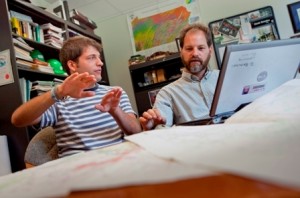
Alec Bernstein '11 (left) works on a project with David Brandes, associate professor of civil and environmental engineering.
As golden eagles travel through Pennsylvania along the Kittatinny Ridge on their migratory path between Quebec and southern Appalachia, some are wearing backpack-style tracking units that tell researchers on the ground where they have flown.
The data is giving David Brandes, associate professor of civil and environmental engineering, and an interdisciplinary team of scientists a detailed picture of where the migrating birds prefer to fly, information that can help determine how energy-producing wind turbines placed along those ridges affect the birds.
Brandes has been collaborating with scientists from West Virginia University, Ohio State University, Quebec Ministry of Natural Resources, and Hawk Mountain Sanctuary to better understand, quantify, and model how golden eagles react to terrain and weather conditions during migration. The project is funded by a U.S. Department of Energy grant and previously received two Pennsylvania Game Commission State Wildlife grants and a grant from the Pennsylvania Department of Conservation of Natural Resources.
In recognition of their work, the researchers received the 2011 Conservation Award from the Pennsylvania Society of Ornithology.
“The award is a real honor for our team,” Brandes says. “It shows that our research is highly relevant, not just from a scientific viewpoint but also for conservation issues of current concern in Pennsylvania and throughout the Appalachians.”
Although wind energy is seen by some as a green solution to the country’s energy needs, Brandes believes it is necessary to improve scientific understanding of how wind turbines in higher elevations affect the eagles that soar in the same airspace, and whether the turbines pose a hazard to the birds—either through direct collisions or through indirect impacts such as displacement from favored migration routes and wintering areas.
“Ultimately by better understanding the conflict, we think that we can have both wind energy and eagles,” Brandes says.
So far, the team’s data show that eagles preferentially fly at lower altitudes along mountain ridges. Therefore, construction of turbines should be avoided in areas where updrafts are prevalent. In addition, the data clearly show that migration is not random: There are pathways used year after year.
The team has also begun analyzing information from new cell-based transmitters that send data at 30-second intervals, giving an unprecedented view of eagle flight behavior. However, it will take some time to collect the datasets to understand how eagles respond to turbines in the landscape. In order to draw valid conclusions, they must be able to contrast data collected before and after construction of wind turbines in a particular area.
This spring, Brandes took his interest in the subject of wind energy and flight migration patterns across the Atlantic. While leading Lafayette’s engineering study abroad program in Madrid, Brandes had the opportunity to repeatedly visit an area near the Strait of Gibraltar, where scientists are studying raptor migration.
“It’s an interesting location because hundreds of thousands of birds migrate past, but most of the casualties are local birds, especially griffon vultures,” Brandes says. “We are learning that most of the time, the birds have an easy time avoiding the turbines, but if winds are marginal, they struggle for lift and tend to circle near the blades. There is a fascinating interplay of species-specific flight dynamics, terrain, and wind that seem to determine when conditions are most risky for the birds. The research is especially interesting to me because it involves raptors, topography, and fluid mechanics – three of my favorite subjects.”
In related work, Brandes is part of a multidisciplinary group of researchers led by Gil Bohrer of Ohio State working on a new grant from NASA: “Discovering relationships between climate and animal migration with new tools for linking animal movement tracts with weather and land surface data.” He will be developing a tool for estimating uplift based on wind and digital topography.

2 Comments
Comments are closed.